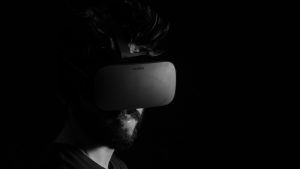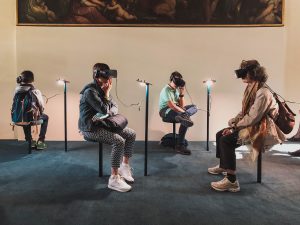In today’s world of intelligent technologies and more significant talent gaps, the need for training and development has never been so critical. As skills are short-lived, businesses are feeling the squeeze.
This is the main reason why companies are spending thousands of dollars on training their employees.
The graph below shows the average spend on workplace training for employees.

Source: Statista
Sadly only 34% of companies feel that training is efficient. Thus, as technology and market competition continues to grow, L&D professionals must come up with the best possible solutions to make training effective.
But the million-dollar question is, what is the most effective method of training?
Traditional employee training involves a unique blend of scalable approaches such as on job training, classroom training, the use of audiovisual presentations,1:1 training, and so on.
Since bulk training does not make a big impact on productivity, the only alternative is 1:1 in-person training. However, it is nearly impossible to train all employees on a 1:1 basis mainly due to the shortage of staff and soaring training charges.
The best suitable option here is to provide an immersive training experience to employees.
So why should you use VR for job training?
Companies that have implemented immersive learning with VR were stunned by the incredible results it could yield compared to regular training manuals and videos.
Immersive VR training programmes also help save a considerable amount of time compared to regular in-person training.
One unique advantage of VR is that it can offer 1:1 training instantly. Modules can be carefully designed with instructional designers based on the learner’s available time and experience. In short, it almost feels like 1:1 training.
Virtual reality training programmes help give attendees corrective feedback instantly in case they get a question wrong, helping them retain information better.
Thus, training through VR helps to improve preparedness, engagement, confidence and retention. In addition, carefully designed immersive learning courses help make the right nerve connections when making decisions in the real world.
Another reason is that immersive VR technology helps in on-the-job training without putting employees at any risk of accidents or company downtime.
Growth Academy Asia utilises advanced virtual learning applications powered by Jenson8 – a virtual reality technology recognised in theGartner 2021 Market Guide for Corporate Learning. This allows us to provide immersive VR training programmes and also helps save a considerable amount of time compared to regular in-person training.
Read more in our article on “Immersive Virtual Reality.”
The secret mantra for deriving the best result from VR training is virtual reality + behavioural psychology + gamification techniques + expert guidance.
VR platforms that use AI and machine learning help to create highly engaging and immersive learning journeys. Companies can assess and improve the performance of team members in a physically safe group environment.
To surmise VR training helps in:
- Aligning business and talent goals
- Analysis of KPIs (key performance indicators)
- Addressing generational issues
- Better employee communication
- Realise a globally diverse workforce
- Employee onboarding and retention plans
Read our article on “Virtual reality training” to learn more.
VR for leadership training
In the modern corporate world, where management challenges are rising every day, leadership training helps to expand the capacity of individuals to perform managerial and leadership roles in the organisation.
Leadership training typically covers a range of topics, including:
- Conflict management
- Change management
- Emotional intelligence
- Employee empowerment
- Team Management
- Verbal and oral communication
With a fully simulated experience, VR can offer leadership training in a risk-free and immersive environment.
Attendees can learn without having to travel to the training location and participate in role-playing activities in a safe environment,
How does VR help in skill development?
One of the unique features of VR, when compared to other forms of training methodologies, is that it creates an entirely immersive environment that simulates real life.
Studies have shown that experiential learning is the most potent way to memorise and strengthen skills. By engaging with tools and other objects, the quality of learning and retention can be boosted by 90%.
Since virtual reality training is an immersive learning experience, it helps to stimulate work challenges by creating real-life work scenarios. Staff can enter their virtual office, warehouse, or store to gain job training in a perfectly risk-free environment.
The most proven way to overcome challenges is to learn by doing. Retention of skills acquired through virtual reality training is high; this means people are likely to remember the skills and apply them at various work situations-strengthening productivity.
Research done by PwC has indicated that learners are 3.75 times more emotionally connected to digital content and can learn four times faster.
The same study also has revealed a 275% improvement in confidence level in the trainees and was focussed four times more than their peers who were trained using other digital solutions.
The technology of virtual reality is so flexible that almost any known environment can be simulated. This means even high risk or dangerous environments can be created with a safe working space to learn high-risk skills and allow users to confidently apply the needed skills without worrying about the consequences.

Virtual reality training systems
In a broader sense, the VR training system consists of VR hardware and VR software.
1. VR hardware
The virtual reality hardware works in sync with the VR software system. The standard hardware used includes gloves, VR glasses and other additional accessories to simulate the sense of touch.
2. VR software
VR software helps to create the illusion of a virtual environment needed for training. The developers often embed interactive components within the software to ensure that the virtual world looks as natural as possible.
Benefits of using VR for job training
There are innumerable benefits of using VR for job training. They are:
1. Accelerated learning
In today’s highly competitive business environment, every second counts. Since humans are naturally programmed to learn through their five senses, training through VR can help employees and students effectively absorb and retain information.
Research has indicated that people tend to lose concentration after eight seconds which is notoriously a shorter concentration span than a goldfish. This is mainly due to the ample distractions of a modern lifestyle.
By wearing immersive VR headsets, it is possible to block distractions and help people focus better.
2. Improved creativity
All businesses need to indulge in taking risks to propel their business forward. However, not all employees are comfortable with the idea of risk-taking since most of us are accustomed to the idea of staying in our comfort zones.
Since the training is virtual, employees can take all the risks necessary to test new practices or ideas. This will also help to bring forth a high level of engagement during training sessions.
3. Enhanced learning and performance
Studies have shown that people mostly learn 70% through experience, 20% from other sources, and 10% through formal education.
The best thing about practical training is that retaining information, learning new abilities and altering behaviours is more effective when done practically. The ultimate strength of virtual reality lies in its ability to provide a realistic environment, helping trainees to gain hands-on experience.
This allows the participants to make mistakes and receive immediate feedback through performance-related metrics. In addition, the newly acquired skills can be strengthened by repeating the training multiple times.
4. Cost reduction
The financial benefits offered by VR training for companies is mesmerising.
It is true that initial investment for the hardware and designing the training course is necessary. However, once the training is fully designed, companies can eliminate the unnecessary cost of repeated in-person training.
Indirect cost can also be avoided, minimising the downtime and eliminating the need to stop production. This also helps to improve productivity by having proficient and better-trained staff.
5. Allows remote training
Since VR can be accessed from anywhere, anytime, the need for bringing trainers and trainees under one roof can be avoided. This helps make the training accessible to employees spread across the globe and cut down on unnecessary travel expenses.
The future of VR training
In recent years we can see a rapid shift in which more and more companies opt for innovative technologies to develop future talent within corporate training.
Among all these technologies, virtual reality is undoubtedly the first choice for companies. Therefore, it is primarily anticipated that VR technology will be commonly used everywhere for training purposes.
Ever since VR came into the limelight, specific industries such as military and pilot training have instantly adopted it and made it a great success.
As a result, VR is now expanding to more areas as a commonly sought after method to effectively train a particular skill before it needs to be applied at the work situation.
Market research has indicated that virtual mentorship takes off across all industries. Programs like these will enable new team members to directly collaborate with managers to overcome any new roadblocks. In addition, this will help inexperienced workers to improve their productivity and success rate with VR.
In tomorrow’s world, the whole sphere of corporate training is going to revolve around innovative technologies.
VR is going to be the first preference for companies when it comes to giving corporate training.
Check out the diversity inclusion training programs and exercises to understand further on how it can help in creating an effective team in a diverse workplace.

Bottom Line
Virtual reality is no longer limited to sci-fi movies. Hundreds of companies have gained tremendous success in implementing VR training programs.
With VR, learner engagement and retention outperform traditional marketing methods and one-to-one instructor-led training.
In the sphere of enterprise training, the technology of VR helps to bridge traditional classroom experience with on-job training.
VR holds a promising future for L&D by moulding the learning landscape in the field of industrial training.
Call us at Growth Academy Asia for all your virtual reality-based queries.
The article is a part of our comprehensive series on “Virtual Reality”





